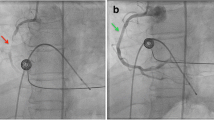Abstract
Purpose: Peripheral atherosclerosis (renal and aortoiliac localizations) are frequently detected in aged patients with concomitant coronary artery disease (CAD): the risk of finding peripheral disease is increased in patients with CAD. Angiography of the aortoiliac vessels performed at the time of coronary angiography may detect any occult renal artery stenosis and atherosclerotic involvement of the aortoiliac segment. We sought to determine utility of performing angiography of aortoiliac and renal arteries during coronary arteriography in patients with known or suspect coronary atherosclerosis. Methods: Medical records of all patients undergoing combined coronary and aortoiliac angiography between May 1998 and December 2002 was retrospectively reviewed. Moderate to severe arterial stenosis (>50% stenosis), vessel occlusion, aneurismal vessels were noted as significant angiographic findings. Contrast-induced nephropathy was defined as a rise in serum creatinine of ≥25% form baseline. Results: In the study period 112 patients (81 males, mean age 68.4 ± 7.8 years) with known or suspected CAD underwent combined cardiac catheterization and aortoiliac angiography. Pretreatment with 0.45% saline at a rate of 1 ml/kg/h for 12 h was administered to all patients. Significant findings were reported in 37 (33%) patients including 14 renal artery stenoses, 8 aortic aneurismal disease, and 15 aortoiliac lesions. Most patients with significant findings had 2 and 3-vessel CAD. A strong correlation was found between the number of risk factors and the frequency of angiographic findings (r= 0.92). Complications include six contrast-induced nephropathy: no case required renal replacement therapy. Conclusions: Aortoiliac and renal atherosclerosis is frequently associated to multivessel CAD. In selected patients undergoing cardiac catheterization aortoiliac angiography may be practical in detecting occult renal or aortoiliac artery lesions. Further clinical outcome studies are strongly required to support this strategy.
Similar content being viewed by others
References
Rigatelli G, Zanchetta M.Interventional treatment of noncoronary atherosclerosis:What the cardiologist would know.Ital Heart J 2004;5:99–113.
Kafetzakis A, Giannoukas AD, Kochiadakis G,et al.Oc-cult aorto-iliac disease in patients with symptomatic coro-nary artery disease.Int Angiol 2001;20:295–300.
Hodara M, Bonithon-Kopp C, Courbon D, Guerin F, Richard J.Extra coronary atherosclerosis in documented coronary patients.Arch Mal Coeur Vaiss 1998;91: 201–207.
Harding MB, Smith LR, Himmelstein SI,et al.Renal artery stenosis:prevalence and associated risk factors in patients undergoing cardiac catheterization.J Am Soc Nephrol 1992;2:1608–1616.
Weber-Mzell D, Kotanko P, Schumacher M, Klein W, Skrabal F.Coronary anatomy predicts presence or absence of renal artery stenosis.A prospective study in patients undergoing cardiac catheterization for suspected coronary artery disease.Eur Heart J 2002;23:1684–1691.
Jean WJ, Al-Bittar I, Zwicke DL, Port SC, Schmidt DH, Bajwa TK.High incidence of renal artery stenosis in pa-tients with coronary artery disease.Cathet Cardiovasc Diagn 1994;32:8–10.
Yamashita T, Ito F, Iwakiri N, Mitsuyama H, Fujii S, Ki-tabatake A.Prevalence and predictors of renal artery ste-nosis in patients undergoing cardiac catheterization. Hypertens Res 2002;25:553–557.
Atmer B, Jogestrand T, Laska J, Lund F.Peripheral artery disease in patients with coronary artery disease.Int Angiol 1995;14:89–93.
Rangel A, Albarran H, Solorio S, Hernandez-Gonzalez MA.Angiographic concurrence of coronary artery disease and aortoiliac lesions.Angiology 2002;53:685–692.
Iacovino JR.Additional mortality produced by co-existent cerebral and peripheral atherosclerosis in a population with coronary artery disease.J Insur Med 1998;30:68–75.
Takahashi J, Okude J, Gohda T,et al.Coronary artery bypass surgery in patients with abdominal aortic aneurysm: Detection and treatment of concomitant coronary artery disease.Ann Thorac Cardiovasc Surg 2002;8:213–219.
Brooks MJ, Mayet J, Glenville Bl.Cardiac investigation and intervention prior to thoraco-abdominal aneurysm re-pair:coronary angiography in 35 patients.Eur J Vasc En-dovasc Surg 2001;21:437–444.
Suggs WD, Smith RB III, Weintraub WS, Dodson TF, Salam AA, Motta JC.Selective for coronary artery disease in patients undergoing elective repair of abdominal aortic aneurysms.J Vasc Surg 1993;18:349–355.
Kishi K, Ito S, Hiasa Y.Risk factors and incidence of coronary artery lesions in patients with abdominal aortic aneurysms.Intern Med 1997;36:384–388.
Islamoglu F, Atay Y, Can L,et al.Diagnosis and treatment of concomitant aortic and coronary disease:A retrospec-tive study and brief review.Tex Heart Inst J 1999;26:182–188.
El-Sabrout RA, Reul GJ, Cooley DA.Outcome after simultaneous abdominal aortic aneurysm repair and aor-tocoronary bypass.Ann Vasc Surg 2002;16:321–330.
Autschbach R, Falk V, Walther T,et al.Simultaneous coronary bypass and abdominal aortic surgery in patients with severe coronary disease-indication and results.Eur J Cardiothorac Surg 1995;9:678–683.
Bayazit M, Gol MK, Battaloglu B, Tokmakoglu H, Tasd-emir O, Bayazit K.Coronary arteriography before abdominal aortic aneurysm repair.Am J Surg 1995;170: 246–250.
Reimer P, Landwehr P.Non-invasive vascular imaging of peripheral vessels.Eur Radiol 1998;8:858–872.
Ubbink DT, Fidler M, Legemate DA.Interobserver vari-ability in aortoiliac and femoropopliteal duplex scanning.J Vasc Surg 2001;33:540–545.
Sensier Y, Bell PR, London NJ.The ability of qualitative assessment of the common femoral Doppler waveform to screen for signi cant aortoiliac disease.Eur J Vasc Endo-vasc Surg 1998;15:357–364.
Hany TF, Debatin JF, Leung DA, Pfammatter T.Evalua-tion of the aortoiliac and renal arteries:comparison of breath-old,contrast-enhanced,three-dimensional MR angiography with conventional catheter angiography. Radiology 1997;204:357–362.
Lundin P, Svensson A, Henriksen E,et al.Imaging of aortoiliac arterial disease.Duplex ultrasound and MR angiography versus digital subtraction angiography.Acta Radiol 2000;41:125–132.
Cronberg CN, Sjoberg S, Albrechtssn U,et al.Peripheral arterial disease.Contrast-enhanced 3D MR angiography of the lower leg and foot compared with conventional angi-ography.Acta Radiol 2003;44:59–66.
Author information
Authors and Affiliations
Rights and permissions
About this article
Cite this article
Rigatelli, G. Aortoiliac Angiography During Coronary Artery Angiography Detects Significant Occult Aortoiliac and Renal Artery Atherosclerosis in Patients with Coronary Atherosclerosis. Int J Cardiovasc Imaging 20, 299–303 (2004). https://doi.org/10.1023/B:CAIM.0000041948.14956.44
Issue Date:
DOI: https://doi.org/10.1023/B:CAIM.0000041948.14956.44




